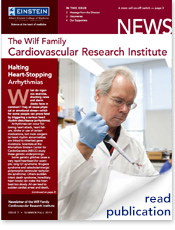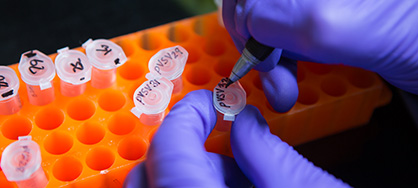Research Highlights
Halting Heart-Stopping Arrhythmias
What do vigorous exercise, shocking news and alarm clocks have in common? They all cause physical or emotional stress — which for some people can prove fatal by triggering a serious heart rhythm disturbance (arrhythmia).
Arrhythmias can occur following heart attack, heart failure, stroke or use of certain medications, but most congenital heart rhythm abnormalities are linked to inherited gene mutations. Scientists at the Montefiore Einstein Center for CardioGenetics (MECC) study these genetic underpinnings.

This article originally appeared in the summer/fall Wilf Family Cardiovascular Research Institute newsletter.Some genetic glitches cause a very rapid heartbeat (for example, long QT syndrome, Brugada syndrome and catecholaminergic polymorphic ventricular tachycardia syndrome). Others (sudden infant death syndrome, hereditary heart block) can make the heart beat too slowly. All can lead to sudden cardiac arrest and death, says Dr. Thomas V. McDonald, co-director of the MECC, which also provides affected families with genetic testing, treatment and genetic counseling.
Without Warning
People at risk for dangerous arrhythmias usually have no symptoms until a trigger creates electrical instability in the heart's ventricles, or pumping chambers. They may then experience a racing or sluggish heartbeat, a skipped beat, shortness of breath or fainting (syncope).
Your heartbeat—the alternating contractions and relaxations of the heart—depends on the coordinated action of ions. These electrically charged atoms of potassium, sodium and calcium flow through ion channels in the membranes of heart muscle cells, explains Dr. McDonald, who is also a professor of medicine (cardiology) and of molecular pharmacology at Einstein and an attending cardiologist at Montefiore, the University Hospital and academic medical center for Einstein.
Genetic Origins
Genetic defects associated with potentially fatal arrhythmias cause the proteins that help build ion channels and regulate the rate at which ions flow through the channels to malfunction. The resulting gain or loss of ion channel function affects the "action potential" of heart muscle cells — the time it takes cells to change from a resting state (when the heart relaxes between beats) to an excited state (when the heart contracts) and back again.
Dr. McDonald has studied mutations of the human ether-a-go-go-related gene (hERG) and the KCNQ1 gene. These potentially fatal mutations abnormally prolong the excited (contracting) state of heart muscle cells. This causes heart muscle to become fatigued and quiver weakly until no longer able to pump oxygenated blood to the brain.
By identifying people with these gene mutations, doctors can prescribe drugs to prevent arrhythmias. "Genetic analysis enables us to better tailor medicines and lifestyle recommendations for patients with specific mutations to reduce the risk of potentially fatal rhythm disturbances," says Dr. McDonald.
For instance, while patients with hERG and KCNQ1 mutations can be treated successfully with beta-blockers to prevent arrhythmias from occurring, those with different mutations that cause a severe and dominant malfunction of ion channels must be treated more aggressively with pacemakers or implantable cardiac defibrillators, he says. These can help control certain heart rhythm problems and may be the best option for a patient who doesn't respond to other interventions.
Posted on: Wednesday, January 22, 2014

Q: Sudden infant death syndrome (SIDS) is associated with accidental suffocation, but research also points to congenital defects affecting heart rhythm as factors. Should parents continue to follow SIDS prevention recommendations?
A: SIDS is not a diagnosis but rather an umbrella term for the sudden death of a seemingly healthy infant less than a year old. There are several theories about what causes SIDS, and emerging research suggests that up to 13 percent of cases could be attributable to a genetic defect that causes heart rhythm problems. To reduce the risk of avoidable suffocation, parents should continue to follow the American Academy of Pediatrics SIDS prevention recommendations: lay a baby down to sleep on his or her back; place a baby to sleep on a firm surface; don't let a baby sleep in the parents' bed; and remove fluffy or loose bedding and plush toys from the crib.



Tablet Blog